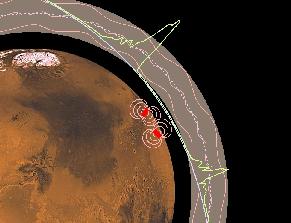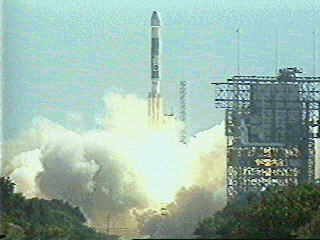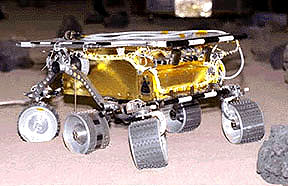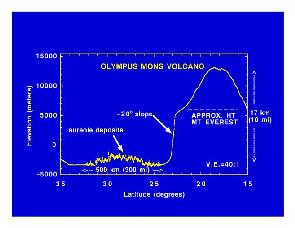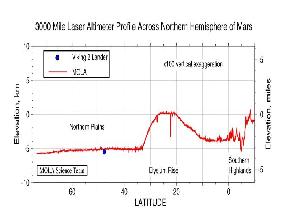Click on image for full size
Image from: NASA/JPL
Aerobraking
On September 12, 1997, the Mars Global Surveyor successfully entered a highly elliptical orbit around Mars. To get into the near-circular, near-polar, low-altitude orbit necessary to map the surface of Mars, MGS would have to undergo a series of aerobraking maneuvers.Originally, MGS was to dip into the upper Martian atmosphere and ionosphere on every orbit for four months. During these atmospheric passes, air resistance generated by the solar panels would slow the spacecraft and gradually lower its orbit. Surveyor was to use this aerobraking technique to lower the high point of its orbit from an initial 56,000 kilometers in altitude to about 400 kilometers. This aerobraking would also force the spacecraft into a near-circular trajectory.
The MGS spacecraft suffered a setback when it was discovered that one of the two solar panels on the spacecraft would not open fully into a latched and secure position. It was determined that a broken shaft from the panel's deployment mechanism had wedged itself such that the panel was 20.5 degrees from full deployment. Both solar panels were generating full power so this setback wasn't a huge threat to the mission. But, because the solar panels actually helped the spacecraft attain its final mapping orbit, it did bring about complications for the aerobraking planned for the mission!
Because the solar panels are used during this aerobraking process, special attention had to be given to the unlatched panel. Controllers decided to rotate the panel so air flow would actually be against the front of the panel instead of the back of the panel as originally planned. This assured that the panel would not fold on itself when air flow occurred during aerobraking. But this rotation also exposed the electricity-producing cells located on the front of the unlatched panel. Because these cells could not resist the heat produced by the air flow, aerobraking had to be executed at a much slower rate. Originally, the MGS was to enter its mapping orbit in the March 1998, but it actually wasn't able to enter that mapping orbit until February 1999 because of the aerobraking process had to be slowed.
When Surveyor initially entered Martian orbit in 1997, the orbital period was about 45 hours. The goal in aerobraking was to bring the orbital period down to 2 hours! The final orbit necessary for mapping was a sun-synchronous, 400 km, circular, polar orbit . To achieve this orbit, a period of aerobraking was begun in September 1998 and lasted until early February 1999 and required almost 700 orbits around the planet. But, finally the mapping orbit was reached on February 4, 1999. Aerobraking was completed on that day and MGS was pulled up out of the atmosphere for good. The farthest point in the orbit (on 2/3/99) was then 506 km with an orbital period of just 1.88 hours. In 2001, the spacecraft's altitude has ranged from about 310 km - 430 km with an orbital period under 2 hours.
It should be noted that aerobraking is an extremely complex process. It depends on the thickness of the atmospheric/ionospheric layer which depends upon the state of the atmosphere, that is, whether it is heating and expanding or cooling and contracting. Successful aerobraking depends upons the correctness of scientists' understanding of the heating and cooling of the atmosphere. This information, together with other spacecraft and ground-based measurements, helps mission controllers to guide the spacecraft during aerobraking.







